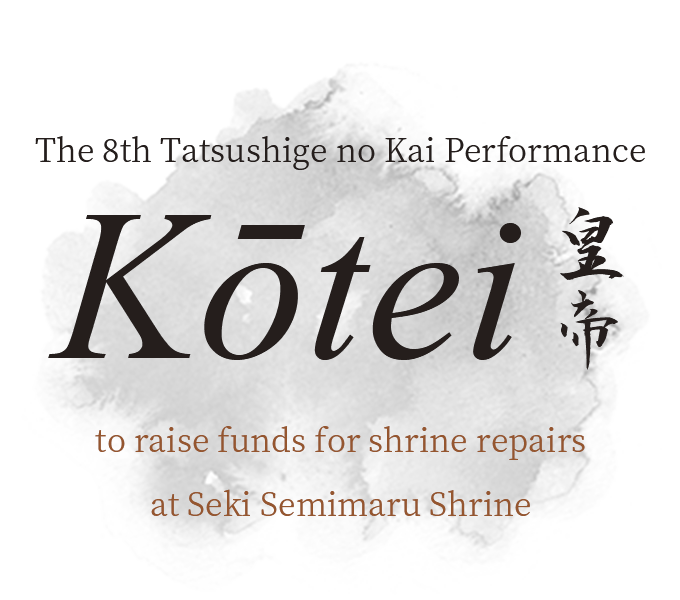第八回 竜成の会 関蝉丸神社勧進能 皇帝【令和5年5月28日】



プログラム
-
- 日時 Date
- 令和5年5月28日(日)午後2時開演(午後1時開場)
-
28 May 2023
2 p.m.-5 p.m. (doors open at 1 p.m.)
-
- 場所 Place
-
金剛能楽堂 The Kongō Noh Theatre kongou-net.com
京都市上京区烏丸中立売上ル
「今出川」駅から徒歩5分 ※駐車場はございませんので、京都御苑の一般駐車場をご利用下さい
Address: Nakadachiuri-agaru, Kamigyo-ku, Kyoto. 602-0912 Karasuma-dori,
Travel directions: The Kongo Nogakudo is easily reachable by subway: get off at Karasuma-Imadegawa (K06), South Exit (n.6), walk South 300m.
演目 Program
-
- 一管 Ikkan (flute solo)
- 左鴻泰弘 Yasuhiro Sako
-
- 独吟「景清」 Dokugin(vocal solo)
- 宇髙竜成 Tatsushige Udaka
-
-
仕舞「清経クセ」
Shimai (dance excerpts)
KIYOTSUNE Kuse -
-
- シテ
- 宇髙徳成
- Shite
- Norishige Udaka
-
- 仕舞「経正キリ」 TSUNEMASA Kiri
-
-
- シテ
- 山田伊純
- Shite
- Isumi Yamada
-
- 地謡
- 宇髙竜成 向井弘記 見越英明 中村洋臣
- Jiutai
- Tatsushige Udaka, Hiroki Mukai, Hideaki Mikoshi, Hiromi Nakamura
-
-
仕舞「清経クセ」
Shimai (dance excerpts)
-
- 狂言「梟」 Kyōgen: Fukuro "OWLS"
-
-
- シテ
- 茂山忠三郎
- Shite
- Chuzaburo Shigeyama
-
- アド
- 山口耕道 山本善之
- Ado
- Kodo Yamaguchi, Yoshiyuki Yamamoto
-
- 後見
- 岡村宏懇
- Koken
- Hironobu Okamura
-
-
(休憩三十分) 30 min. Intermission
-
- 能「皇帝」 Noh: Kōtei "The Emperor"
-
-
- シテ
- 宇髙竜成
- Shite
- Tatsushige Udaka
-
- ツレ
- 惣明貞助
- Tsure
- Tadasuke Soumyou
-
- 子方
- 森山詩織
- Kokata
- Shiori Moriyama
-
- ワキ
- 原大
- Waki
- Masaru Hara
-
- ワキツレ
- 原陸 岡充
- Wakitsure
- Riku Hara, Mituru Oka
-
- 間狂言
- 茂山忠三郎
- Ai-Kyogen
- Chuzaburo Shigeyama
-
- 笛
- 左鴻泰弘
- Fue
- Yasuhiro Sako
-
- 小鼓
- 古田知英
- Kotsuzumi
- Tomohide Furuta
-
- 大鼓
- 森山泰幸
- Otsuzumi
- Yasuyuki Moriyama
-
- 太鼓
- 前川光範
- Taiko
- Mitsunori Maekawa
-
- 後見
- 金剛永謹 廣田幸稔 豊嶋幸洋
- Koken
- Hisanori Kongo, Yukitoshi Hirota, Yukihiro Teshima
-
- 地謡
- 種田道一 金剛龍謹 廣田泰能 田中敏文 宇髙徳成 山田伊純 向井弘記 湯川稜
- Jiutai
- Michikazu Taneda, Tatsunori Kongo, Yasuyoshi Hirota, Toshifumi Tanaka, Norishige Udaka, Isumi Yamada, Hiroki Mukai, Ryo Yukawa
-
-
終了予定 午後五時 End Time 5 p.m.
ご挨拶 Message
流行病と蝋燭の灯り
昨今のコロナ禍により、世の中は大きく変容しようとしています。長い歴史の中で直面してきた危機を、先人達はどの様に乗り越えてきたのか。それは芸能の中に答えがあるのかもしれません。今回は流行病を扱った狂言「梟」、能「皇帝」を上演いたします。
今から100年前に起こった関東大震災の後、小説家・谷崎潤一郎は京都に移り住んだ時期がありました。そして金剛能楽堂で上演された能「皇帝」を鑑賞し、随筆「陰翳礼讃」の中で『能に付き纏う暗さと、そこから生ずる美しさ』を見たと、その時の体験を語っています。私も以前、蝋燭の灯で能面を照らして見た時に、同じ様な感覚を覚えたことがありました。今回はそこにヒントを得て、照明を抑えて、蝋燭の灯を使った上演形式“蝋燭能”でお送りします。
私たちが生きている現代は、過去の時代の層の積み重ねという事ができます。本作を通じて、その時間の層を体感して頂けましたら幸いに存じます。皆様のご来場を心よりお待ち申し上げます。
竜成の会 代表 宇髙竜成
Epidemics and Candlelight
Due to the Covid-19 pandemic the world is about to change greatly. During our long history, how did our predecessors overcome such crises they faced? It may be that we can find the answer to that question in the performing arts. This time my performance features the Kyōgen “Fukuro” (Owls) and the Noh “Kōtei” (The Emperor) which deal with epidemics.
About one hundred years ago, after the Great Kanto Earthquake, there was a time when novelist Jun-ichiro TANIZAKI moved to Kyoto. There he saw the Noh “Kōtei” at the Kongō noh theatre. He described his experience in his essay “In Praise of Shadows” saying, “I’ve seen the darkness that permeates noh and the beauty that arises from it.” Once, on seeing a noh mask illuminated by candlelight, I felt the same way. Taking a hint from that, this time I am sharing with you a performance in “Candlelight Noh”-style using candlelight and reduced lighting.
The modern world we live in could be said to be the accumulation of layers of past eras. It will be my great pleasure if you experience these layers of time through today’s performance. I look forward to seeing you at the theatre.
UDAKA Tatsushige
Contact information : info@tatsushigenokai.com

能楽師シテ方金剛流/昭和56年生まれ
二十六世金剛流宗家・金剛永謹、及び父・宇高通成に師事。
初舞台は3歳。子方時代を経て、プロの能楽師となる。舞台活動の傍ら、初心者にもわかりやすく楽しめる「能楽ワークショップ」を企画し、フランス、韓国、アメリカなど海外でもワークショップを行う。平成27年より自主公演「竜成の会」を主宰。平成29年よりYoutube「竜成の会」チャンネルで動画配信を開始し、より幅広く普及活動に勤める。令和元年「関蝉丸神社芸能大使」に任命される。現在京都を中心に活動中。
Tatsushige Udaka was born in Kyoto, and started his career in Kokata acting from the young age of three years old. He was trained by the 26th head of the Kongo School, Hinasori KONGO, as well as by his father, Michishige UDAKA. Performing since he was young, he has had extensive stage and teaching experience in Noh Threatre. He has travelled, performed, taught, and demonstrated Noh in Japan, South Korea, France, and the United States throughout the last decade. Currently, he is based in Kyoto.
宇髙竜成 後援会タツシゲの会
(入会金・年会費:無料)
年に一度の竜成の会のご案内の他に、定期的にYouTubeチャンネルを通じた文化情報の発信や、
宇髙竜成の公演情報をお知らせします。また会員限定の竜成の会のチケット先行予約もいたします。
是非この機会にご入会下さい。


詳細
-
- 入場料 Fee
-
-
- 特等席
- 18,000円
- SS (Center reserved seats)
- 18,000yen
-
- 一等席
- 12,000円
- S (Center reserved seats)
- 12,000yen
-
- 二等席
- 9,000円
- A (Side reserved seats)
- 9,000yen
-
- 三等席
- 6,000円
- B (mid-center reserved seats)
- 6,000yen
-
- 親子シート
- 7,000円(2名分)
- Family seats
- 7,000yen / 2 people
※1名追加につき3,500円
6歳以上のお子さんと一緒に観劇いただける席です。二階席は親子シートのお客さまのみですので、リラックスしてご覧下さい。 (3,500 yen for an extra seat)
Family seats: The seats for a family within a child over 6 years old (could be a grand-child too) -
- 次世代シート
- 3,000円
- Next Generation seats
- 3,000yen
次世代の能楽ファンを育てる目的でご用意しました。お能を初めてご覧になる方、学生の方、舞台芸術を志す方、これらの条件に一つでも当てはまる方を対象としています。(証明書等は不要) Next Generation seats: We prepared this seats for growing the number of the next generation Noh Theatre fans. The seats are available for the audience who attend Noh theatre performance for the first time, for students, and for someone who is practicing and would like to work in a Theatre field.
チケット売上の一部を寄進者名簿とともに関蝉丸神社へ奉納します A portion of ticket sales will be donated to Sekisemimaru Shrine along with a list of donors.
-
-
より楽しみたい方へ
Modern Japanese translation,
lyrics and mp3 files of chanting. -
竜成の会では、歌詞テキスト・現代語訳付きの謡音源も公開しています。
事前に鑑賞いただく事で、お能の台詞が聞き取りやすくなります。
(公演終了後14日間有効)You'll enjoy "Kōtei" even more if you read the text of the lyrics and translation in modern Japanese available by clicking here.
スタッフ STAFF
-
- 能面
- 宇髙景子
-
- 宣伝美術
- 田中嘉代(かよくらふと)
-
- WEBサイト製作
- 髙瀨フヒト
-
- 制作
- 清水翼(KANKARA Inc.)
-
- 協力
- 関蝉丸神社
-
- 主催
- 竜成の会
-
- Noh Mask
- Keiko Udaka
-
- Publicity Art
- Kayo Tanaka (Kayo Craft)
-
- Web Design
- Fuhito Takase
-
- Associate Producer
- Tsubasa Shimizu (KANKARA Inc.)
-
- Cooperation
- Sekisemimaru Shrine
-
- Presents
- Tatsushige no Kai
宇髙竜成 後援会タツシゲの会
(入会金・年会費:無料)
年に一度の竜成の会のご案内の他に、定期的にYouTubeチャンネルを通じた文化情報の発信や、
宇髙竜成の公演情報をお知らせします。また会員限定の竜成の会のチケット先行予約もいたします。
是非この機会にご入会下さい。
お問い合わせ Contact
- タツシゲの会事務局 Tatsushige no Kai
-
- (24時間)
- TEL
- 080-5321-1501080-5321-1501(受付平日12時~16時)
お電話に出られない場合は折り返しご連絡いたします
- 当日券は、残席がある場合のみ販売いたします。
- 新型コロナウィルス感染防止対策については、
ウェブサイトにて最新情報をご確認ください。
© 2023 Tatsushige Udaka


